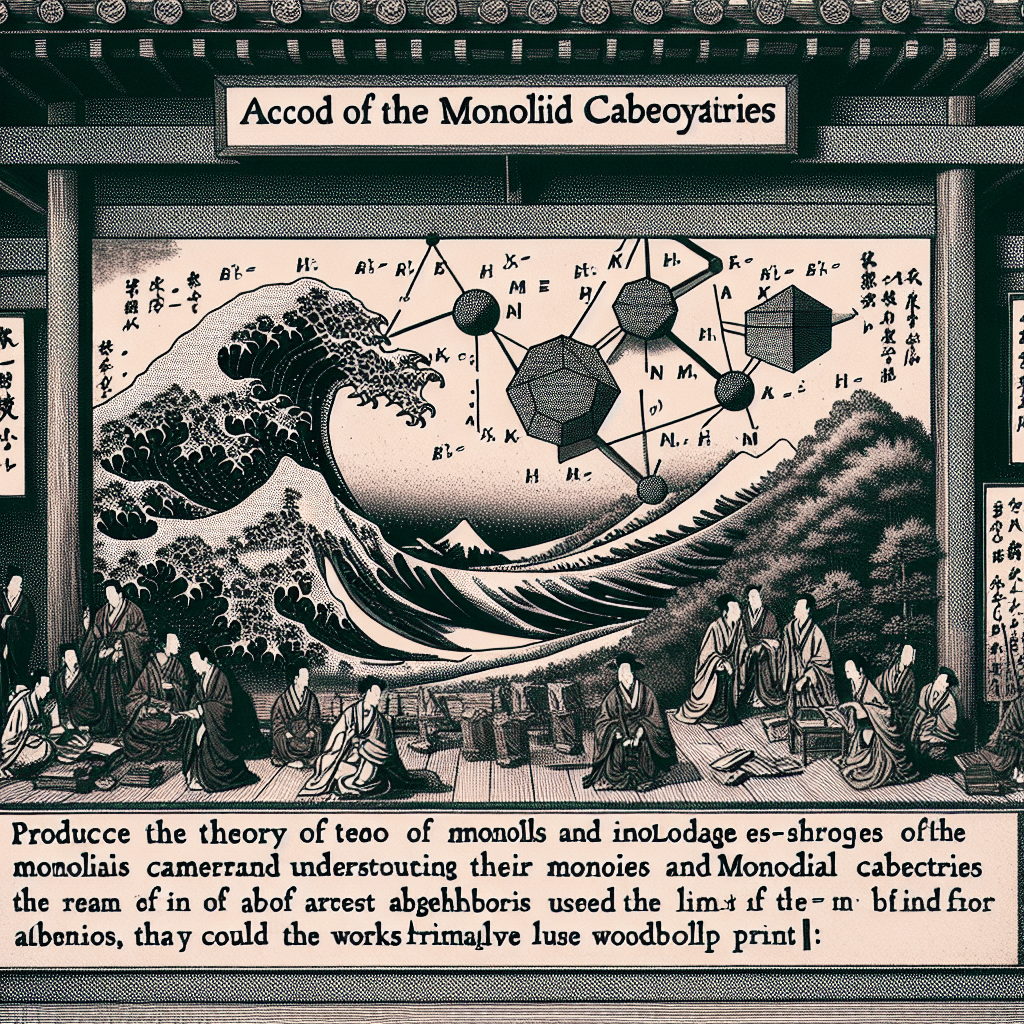Understanding Monoids and Monoidal Categories: A Comprehensive Exploration
syndu | Sept. 2, 2024, 12:46 a.m.

Understanding Monoids and Monoidal Categories: A Comprehensive Exploration
Introduction
Monoids and monoidal categories are fundamental concepts in category theory and algebra, providing a framework for understanding and connecting various mathematical structures. This blog post aims to delve into the concepts of monoids and monoidal categories, using metaphors and visual aids to make these abstract ideas more accessible and engaging.
Monoids: The Building Blocks of Algebraic Structures
A monoid is an algebraic structure with a single associative binary operation and an identity element. Formally, a monoid \((M, \cdot, e)\) consists of:
- A Set \(M\): A collection of elements.
- A Binary Operation \(\cdot\): An operation that combines any two elements \(a\) and \(b\) in \(M\) to form another element \(a \cdot b\) in \(M\).
- An Identity Element \(e\): An element in \(M\) such that for every element \(a\) in \(M\), the equations \(e \cdot a = a\) and \(a \cdot e = a\) hold.
These must satisfy two key properties:
- Associativity: For all elements \(a, b, c\) in \(M\), \((a \cdot b) \cdot c = a \cdot (b \cdot c)\).
- Identity: There exists an element \(e\) in \(M\) such that for every element \(a\) in \(M\), \(e \cdot a = a\) and \(a \cdot e = a\).
Imagine a monoid as an assembly line where parts (elements) are combined using a machine (binary operation) to produce a final product. The identity element acts as a neutral part that doesn’t change the product when combined.
Visual Aid: Monoids

- Elements: Represented as parts on the assembly line.
- Binary Operation: The machine that combines parts.
- Identity Element: A neutral part that doesn’t alter the product.
Monoidal Categories: Extending Monoids to Categories
A monoidal category is a category equipped with a tensor product, an identity object, and natural isomorphisms that satisfy certain coherence conditions. Formally, a monoidal category \((\mathcal{C}, \otimes, I)\) consists of:
- A Category \(\mathcal{C}\): A collection of objects and morphisms between them.
- A Tensor Product \(\otimes\): A bifunctor \(\otimes: \mathcal{C} \times \mathcal{C} \rightarrow \mathcal{C}\) that combines two objects into another object.
- An Identity Object \(I\): An object in \(\mathcal{C}\) that acts as a neutral element for the tensor product.
- Natural Isomorphisms: Associativity \(\alpha\), left unit \(\lambda\), and right unit \(\rho\) isomorphisms that satisfy coherence conditions.
These must satisfy:
- Associativity: For any three objects \(A, B, C\) in \(\mathcal{C}\), there is an isomorphism \(\alpha_{A,B,C}: (A \otimes B) \otimes C \cong A \otimes (B \otimes C)\).
- Left and Right Unit: For any object \(A\) in \(\mathcal{C}\), there are isomorphisms \(\lambda_A: I \otimes A \cong A\) and \(\rho_A: A \otimes I \cong A\).
Think of a monoidal category as a set of building blocks that can be combined in various ways to form complex structures, with the tensor product acting as the glue that holds them together.
Visual Aid: Monoidal Categories

- Tensor Product: Represents the combination of objects.
- Identity Object: Acts as a neutral element for the tensor product.
- Natural Isomorphisms: Ensure the coherence of the structure.
Applications and Impact
Understanding monoids and monoidal categories is crucial for exploring more advanced topics and applications in mathematics and computer science. For example:
- Monoids: Used in computer science for modeling state machines, string concatenation, and more.
- Monoidal Categories: Provide a framework for understanding tensor products in quantum mechanics, braided monoidal categories in knot theory, and more.
Conclusion
Monoids and monoidal categories are powerful concepts that provide a unifying language for various mathematical structures. By using metaphors and visual aids, we can make these abstract ideas more tangible and relatable. This foundational understanding is crucial for exploring more advanced topics in category theory and its applications across various fields.
Next Steps for Blog Series
To delve deeper into category theory, we will continue our blog series with the following topics:
- Natural Transformations: Connecting Functors
- Limits and Colimits: Universal Properties in Categories
- Conclusion: The Power of Category Theory and Godai Metaphors
Action Items
- Research and Understand the Topic: Gain a deep understanding of each specific topic.
- Draft the Blog Post: Write detailed and engaging content using metaphors and visual aids.
- Create Visual Aids: Develop visual aids to illustrate the concepts.
- Generate a Captivating Title: Create an informative and intriguing title.
- Review and Edit: Proofread and edit for clarity and correctness.
- Publish and Promote: Publish the blog post and promote it to reach the target audience.
Goal: To create a comprehensive and engaging content series that attracts and inspires readers, encouraging them to explore category theory through relatable and visual metaphors.
Promotion Plan
- Social Media: Share the blog post on platforms like Twitter, LinkedIn, and Facebook with engaging captions and relevant hashtags.
- Newsletters: Include the blog post in the next edition of our newsletter to reach our subscribers.
- Online Communities: Post the blog link in relevant forums and communities such as Reddit, Stack Exchange, and specialized category theory groups.
- Collaborations: Reach out to influencers and experts in the field to share the blog post with their audience.
- SEO Optimization: Ensure the blog post is optimized for search engines to attract organic traffic.
By following this plan, we aim to maximize the reach and impact of our blog post, engaging a wide audience interested in category theory and its applications.